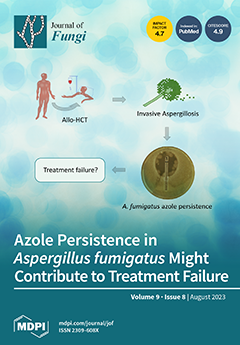The exploration of the western forests of Algeria led to the remarkable discovery of the first occurrence of
Lepista sordida, an edible wild mushroom of significant culinary importance for the local community, traditionally consumed in its natural state. This discovery was made possible through the use of various methods, including macroscopic observations (revealing a violet color) as well as microscopic observations conducted using scanning electron microscopy (SEM), revealing a cylindrical shape with distinct contours. Additionally, molecular analyses were conducted. Genomic DNA was extracted from the mycelium, followed by DNA amplification using specific primers targeting the internal transcribed spacer region (ITS1 and ITS2). After PCR reactions and sequencing of the obtained amplicons, the nucleotide sequences of the mycelium were submitted to the GenBank database of NCBI with the assigned accession number: MZ928450.1. These sequences were subsequently used to construct the phylogenetic tree. Furthermore, an in-depth study of physicochemical parameters was undertaken to determine the optimal conditions for cultivating the mycelium of this edible wild mushroom, including pH, temperature, relative humidity, and light. Different temperatures were examined: 20, 25, 30, 35, 40, and 45 °C. The effect of pH on mycelium growth was studied using a PDA agar medium with buffered values of 4, 5, 5.6, 6, 7, and 8. Similarly, six levels of relative humidity were tested: 14, 50, 74, 80, 95, and 100%. A study on the impact of light on mycelium growth was conducted by exposing Petri dishes inoculated with PDA to a light intensity of 500 lux for 5, 10, 15, 20, and 24 h. The results clearly demonstrated that variations in these different physicochemical parameters significantly influenced mycelium growth. For the
Lepista sordida strain, growth was favored at pH levels of 4, 5, 6, and 6, with no growth observed at pH 7 and 8. The optimal temperature range for mycelium growth of
Lepista sordida was 20–25 °C, while no growth was observed at 30, 35, 40, and 45 °C. Relative humidity levels of 74, 80, and 95% showed no significant differences. Optimization of mycelium growth and primordia production in
Lepista sordida were successfully achieved. Optimal conditions for the primordia phase were identified as 25 °C, with humidity ranging from 90 to 95%. A nutritional analysis of fresh sporophores was conducted using established analytical methods. Notably, the nutritional composition of
Lepista sordida sporophores exhibited high significance for the following parameters: moisture content (67.23 ± 1.90%), ash content (9.35 ± 0.66%), fat content (3.25 ± 0.24%), protein content (17.22 ± 0.38%), and carbohydrate content (63.83 ± 1.23%).
Full article
 to open them.
to open them.





